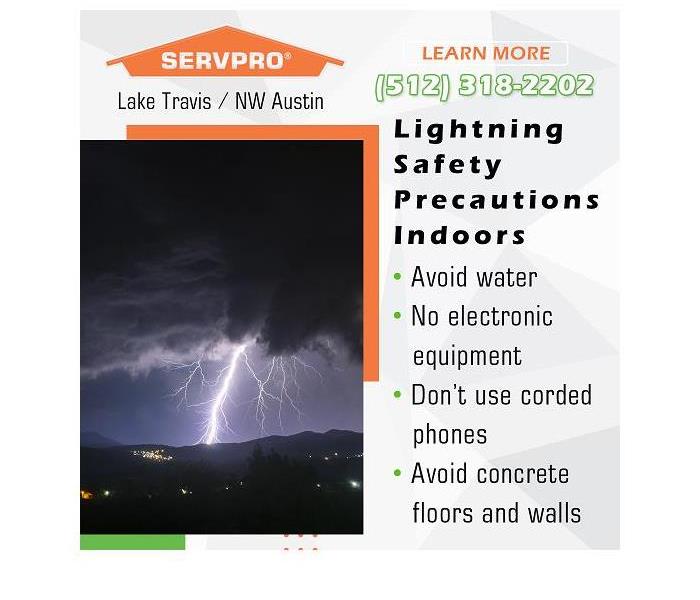SERVPRO: How to Protect Against Lightning Strikes?
7/21/2021 (Permalink)
Blog summary: The article by SERVPRO states facts about lightning and suggests several lightning safety tips.
Lightning facts and safety tips
Lightning kills as many as 2,000 people worldwide, every year. Hundreds of people get struck but survive, usually with lingering and debilitating symptoms. Although the odds of being struck by lightning in a year are less than 1 in a million, some factors can put individuals at greater risk. Lightning usually strikes people who work outside or engage in outdoor recreational activities. SERVPRO, a storm damage restoration company, shares important facts about lightning and some safety tips.
Facts about lightning
- All thunderstorms produce lightning and are dangerous.
- Lightning often strikes outside the area of heavy rain, as far as 10 miles beyond.
- Many lightning deaths occur before and after the storms.
- If one can hear thunder, lightning is an imminent threat.
- Lightning leaves many victims with permanent disabilities. Only about 10% of lightning victims die whereas many survivors struggle with intense pain, neurological disabilities, depression, and other health effects.
Lightning safety precautions outdoors
When outside, the following precautions must be taken to protect from lightning:
- Listen to the forecast: Avoid stepping out in the first place. If there is a prediction of a thunderstorm or lightning, postpone the trip or outdoor activity. Stay home.
- Thunder means danger: If thunder can be heard, it is close by. Find a safe, enclosed shelter such as homes, offices, shopping centers, and hard-top vehicles with the windows rolled up.
- Follow the 30-30 rule: Once lightning is sighted, count till 30. If it thunders before the count of 30, go indoors. After the last clap of thunder, suspend all activities and stay indoors for at least 30 minutes.
- No tents: Most modern tents have carbon fiber or metal poles. They can become a grounding path for a cloud-to-ground lightning strike.
- In case of no shelter: Crouching can reduce the chances of being struck but does not eliminate all danger. Here are few steps to take when there is no safe shelter nearby:
- Climb down: Immediately get off elevated areas such as hills, mountain ridges, or peaks. Never take shelter under a cliff or rocky overhang. Find a low-lying place such as a ravine or a valley, but beware of flash floods.
- Baseball catcher’s position: Crouch down in a baseball catcher’s position, with heels on the ground, ears covered, and head between the knees. Ensure minimal contact with the ground. Never lie flat on the ground.
- Thick forest: Never shelter under an isolated tree. Find a low area under a thick growth of small trees.
- Steer clear of water: Immediately move away from ponds, lakes, and other bodies of water.
- Stay away from conductors: Objects that conduct electricity (such as barbed wire fences, power lines, or windmills) must be avoided.
- No concrete: Stay away from concrete floors or walls as lightning can travel through any metal wires or bars in concrete walls or flooring.
Lightning safety precautions indoors
Being indoors is safer than being outdoors during a thunderstorm. But statistically, about one-third of lightning-strike injuries occur indoors. Follow the tips below to keep safe from lightning while indoors:
- Avoid water: Do not bathe, shower, wash dishes, or have any other contact with water during a thunderstorm. Water, as well as plumbing pipes, are good conductors of electricity.
- No electronic equipment: Lightning can strike through electrical systems, radio, and television reception systems. Don’t plug or unplug electrical equipment during the storms.
- Don’t use corded phones: Avoid using corded phones during a thunderstorm. Instead, opt for cordless or cellular phones.
- Avoid concrete floors and walls: Lightning can travel through metal wires or bars in concrete walls or flooring. Therefore, do not lie on concrete floors during a thunderstorm.
Follow these precautions to avoid being struck by lightning. If a person is struck by lightning, call 911 and get medical help right away. For storm damage restoration services, call a professional team such as SERVPRO right away.
Why SERVPRO?
- SERVPRO uses state-of-the-art equipment to bring the damaged property back to its original state. SERVPRO of Lake Travis / NW Austin is always updating its fleet and equipment so clients in Lake Travis / NW Austin, or anywhere else can quickly access the services.
- With over 1,700 US and Canadian Franchise locations, SERVPRO is strategically positioned to respond faster to an emergency of any magnitude.
- The SERVPRO staff is highly trained in property damage restoration. They receive initial in-house training and constant skill up-gradation at the corporate training facility and also acquire the regular IICRC-industry certification.
For storm damage restoration services in Leander and surrounding areas, call SERVPRO of Lake Travis/NW Austin today at (512) 318-2202.

 24/7 Emergency Service
24/7 Emergency Service
